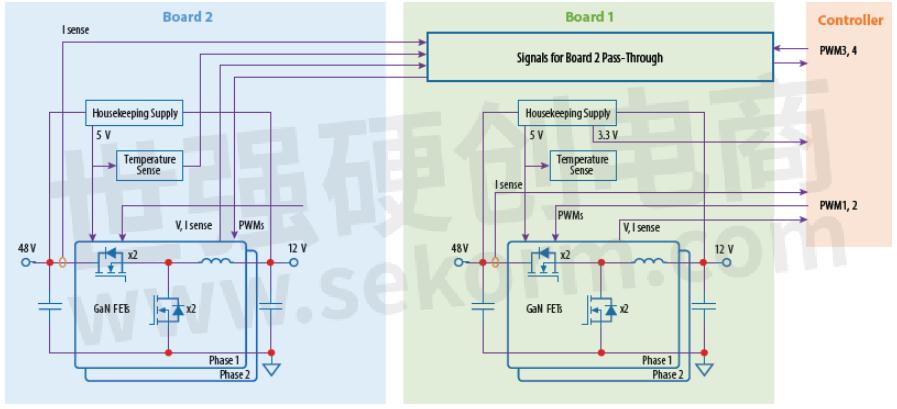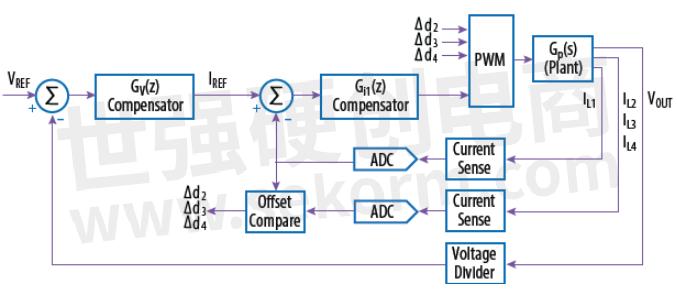The 48V/12V Automotive Evaluation Power Modules Utilize the Two-phase Synchronous Buck/Boost Topology to Achieve Four-phase.

EPC's 48V/12V automotive evaluation power modules (EPC9137, EPC9163, EPC9165, etc) utilize the two-phase synchronous buck/boost topology. The edge connectors and controller card are also designed to operate two modules in parallel with one controller, effectively achieving four-phase and therefore double the rated current and power. An example using EPC9137 modules are shown in Figure 1.

Figure 1. Two EPC9137s connected in parallel to achieve 3kW (12V/ 250A) output using one EPC9528 controller.
Connection
The difference between this two-board configuration and a four-phase converter is the 12V connection impedance. Ideally, this impedance should be extremely low to achieve inductor current ripple cancelation. Therefore, the 12V (low voltage) should be connected using a bus bar, or 8 AWG short wires to ensure low impedance, as illustrated in Figure 2. The connection for 48V (high voltage) bus is less critical. But low impedance is still preferred to avoid parasitic resonance. Ground wires (GND) should also be paired with the corresponding bus and avoid ground loops.

Figure 2. Two EPC9137s connected in parallel with one EPC9528 controller, showing 48V bus and 12V bus connections. The 12V bus requires low impedance between the boards.
Sensing and PWM
Sensing and PWM signals are routed through the edge connectors, as shown in Figure. 3. Make sure to remove any jumper on J800 on both boards. The 3.3V for the controller is only provided by Board 1. Each board generates its own 5V supply. Due to the pin limits on the edge connector, only 2-board parallel is supported. The phase shift of the PWM signals is modified to ensure proper ripple cancelation: PWM1 and 2 are 180 degrees out of phase, so as for PWM3 and 4, and 90 degrees phase shift is between PWM 1 and 3.

Figure 3. Block diagram of the two boards connected with one controller.
Control
Average current mode control with out-of-band current balancing is used. A simplified control diagram is shown in Figure 4. The outer voltage loop generates the current reference IREF for phase 1 inductor average current IL1. The remaining phase inductor currents IL2, IL3, IL4 are sensed and compared to IL1. If there is any imbalance, a duty cycle offset Δd for each phase is generated to minimize the imbalance. This happens at a much lower frequency compared to the main control loop, usually at 10kHz.

Figure 4. Control diagram of the average current mode control loop
Thermal
Due to the direction of heatsink fins, the board downwind will receive reduced airflow for cooling. A minimum of 2000 LFM is required when operating close to rated power. The actual output power may be less than the sum of two individual boards due to inadequate cooling.
Experimental Results
Figure 5 shows the measured efficiency and loss for two EPC9137 boards operating at 48V input and 12V output. Figure 6 shows the corresponding thermal image at full load (12V, 250A output). Due to the airflow direction, the board placed downwind is hotter.

Figure 5. Measured efficiency and loss for two EPC9137s connected in parallel. VIN = 48V, VOUT = 12V, f = 250kHz.

Figure 6. Example thermal image of two EPC9137s. VIN = 48V, VOUT = 12V, IOUT = 250A, f = 250kHz. Downwind board is hotter
Summary
The 48V/12V automotive evaluation power modules are designed to be parallel to achieve double the rated power, when properly cooled. Detailed connection diagram, control method as well as current balancing are given. An example system with two EPC9137s and one EPC9528 is tested at 3kW output when converting 48V to 12V.
- +1 Like
- Add to Favorites
Recommend
- EPC Introduces EPC9157 48V to 12V Demo Board Featuring EPC eGaN FETs and New Renesas DC-DC Controller
- EPC Launches Scalable DC-DC Demonstration Board for Mild-Hybrid Cars and Battery Power Backup Units
- EPC‘s New EPC9165 Bidirectional Converter that Delivers 2kW with 96.8% Peak Efficiency
- Design High-Performance Class-D Audio Amplifiers with EPC’s New Reference Design EPC9192 and eGaN FETs
- Sharge Selects GaN FETs EPC2218 from EPC for High-power USB PD Charger Retro 67 to Achieve the Most Efficient Power Conversion
- EPC Announces EPC9193 eGaN® FET Based 3-Phase BLDC Motor Drive Inverter for Low-Cost E-Bikes, Drones and Robotics
- EPC Launches a 3-phase BLDC Motor Drive Inverter EPC9173 with Embedded Gate Driver Function and a Floating Power GaN FET with 3.3mΩ RDS(on)
- Sekorm Became an Authorized Distributor of EPC(Efficient Power Conversion), Which Brings GaN FET Products
This document is provided by Sekorm Platform for VIP exclusive service. The copyright is owned by Sekorm. Without authorization, any medias, websites or individual are not allowed to reprint. When authorizing the reprint, the link of www.sekorm.com must be indicated.






























































































































































































































































































































































































































































































































































































































































































































































































































































































